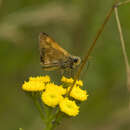North American Ecology (US and Canada)
provided by North American Butterfly Knowledge Network
Ochlodes sylvanoides is a year-round resident in southwestern British Columbia, Canada, throughout much of the northwestern United States and south through California and into northern Baja, Mexico (Scott 1986). Habitats are chaparral, sagebrush and woodland. Host plants are grasses of multiple species. Individuals overwinter as first instar larvae. There is one flight each year, mostly late July-Aug.31. with two flights in the California central valley between late June-Oct.31, and several flights between April.1-Aug.31 on Santa Cruz Island (Scott 1986).
Conservation Status
provided by University of Alberta Museums
Both subspecies are currently ranked as S2 (ANHIC 2000).
- license
- cc-by-nc
- copyright
- University of Alberta Museums
Cyclicity
provided by University of Alberta Museums
One generation per year, with flight activity peaking in mid- to late August.
- license
- cc-by-nc
- copyright
- University of Alberta Museums
Distribution
provided by University of Alberta Museums
Central B.C., southern Alberta, and southwestern Saskatchewan south to Baja California, Mexico and northern New Mexico (Opler 1999). The Woodland Skipper appears to have expanded its Alberta range northward over the past 20 years (Kondla 2001, Schmidt et al. 2003).
- license
- cc-by-nc
- copyright
- University of Alberta Museums
General Description
provided by University of Alberta Museums
"Most likely to be confused with our Polites skippers, particularly mystic and themistocles. Sylvanoides can be separated from themistocles by the hindwing underside, which is brownish yellow, not dark tawny-brown as in themistocles. The Woodland Skipper flies later in the year than P. mystic, and the dark marginal border of the forewing upperside is jagged and well defined, not blending into the orange median area as in mystic.
Subspecies sylvanoides (extreme southwestern Alberta) is slightly darker and smaller than the prairie subspecies napa (Layberry et al. 1998)."
- license
- cc-by-nc
- copyright
- University of Alberta Museums
Habitat
provided by University of Alberta Museums
Open, shrubby areas and grasslands in the southern mountains and prairies.
- license
- cc-by-nc
- copyright
- University of Alberta Museums
Life Cycle
provided by University of Alberta Museums
The egg is undescribed. First instar larvae overwinter, and are cream in colour with a black head (Bird et al. 1995). Mature larvae have variously been described as yellowish with two dark bands (Bird et al. 1995) or seven black longitudinal lines (Opler 1999). The head is black or creamy tan (Opler 1999). Pupae are yellowish tan in colour (Bird et al. 1995). Unlike many grass skippers (Hesperiinae), Woodland Skippers are much more easily approached and can be observed at close range.
- license
- cc-by-nc
- copyright
- University of Alberta Museums
Trophic Strategy
provided by University of Alberta Museums
There are no specific literature records for the grass species the larvae feed on; broad-leaved grasses are often cited (Opler 1999). Adults are fond of nectaring at composites (Compositeae) such as thistles (Cirsium) and knapweed (Centaurea).
- license
- cc-by-nc
- copyright
- University of Alberta Museums
Ochlodes sylvanoides
provided by wikipedia EN
Ochlodes sylvanoides, the woodland skipper, is a butterfly of the family Hesperiidae. It is found in North America from British Columbia south to southern California, east to Montana, Colorado and Arizona.[2]
The wingspan is 25–32 mm. The upperside is orange with toothed brown borders. The forewing of the males has a black stigma, while females have or a black diagonal band. There is a large reddish patch on the hindwings. The underside is variable in colour, ranging from yellow to reddish to brown. The hindwing varies from unmarked to having a distinct band of cream to yellow spots. Adults feed on flower nectar.
The larvae feed on various Poaceae species, including Cynodon dactylon, Phalaris, Elymus and Agropyron species.
Subspecies
-
Ochlodes sylvanoides sylvanoides (California, Mexico)
-
Ochlodes sylvanoides pratincola (Boisduval, 1852)
-
Ochlodes sylvanoides napa (Edwards, 1865)
-
Ochlodes sylvanoides bonnevilla Scott, 1981 (Nevada) – Bonneville skipper
-
Ochlodes sylvanoides orecoasta Scott, 1981 (Oregon) – Oregon coast skipper
-
Ochlodes sylvanoides santacruza Scott, 1981 (northern California)
-
Ochlodes sylvanoides omnigena Austin, 1998 (Nevada, Great Basin)
-
Ochlodes sylvanoides catalina Emmel & Emmel, 1998
References

- license
- cc-by-sa-3.0
- copyright
- Wikipedia authors and editors
Ochlodes sylvanoides: Brief Summary
provided by wikipedia EN
Ochlodes sylvanoides, the woodland skipper, is a butterfly of the family Hesperiidae. It is found in North America from British Columbia south to southern California, east to Montana, Colorado and Arizona.
The wingspan is 25–32 mm. The upperside is orange with toothed brown borders. The forewing of the males has a black stigma, while females have or a black diagonal band. There is a large reddish patch on the hindwings. The underside is variable in colour, ranging from yellow to reddish to brown. The hindwing varies from unmarked to having a distinct band of cream to yellow spots. Adults feed on flower nectar.
The larvae feed on various Poaceae species, including Cynodon dactylon, Phalaris, Elymus and Agropyron species.
- license
- cc-by-sa-3.0
- copyright
- Wikipedia authors and editors

